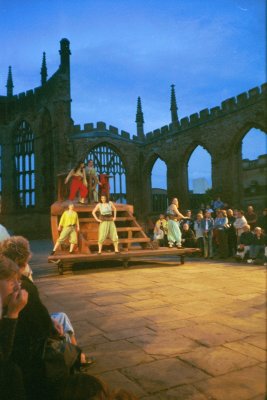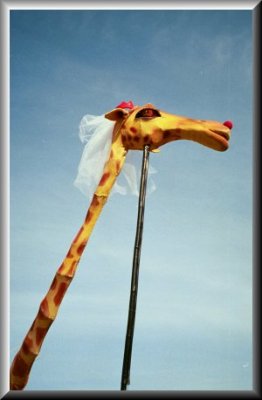There are two ways in which we are using the concept of community today; one of these is as a concept of geography, a place in which we live, work and play; also, within that place, there are some with whom we share a "common experience" community, a connectedness with people who share our world view.
1.
Communities are the gathering together of peoples; they are places where people live, work, and play. They are human settlements. This can be a small town, village, or city. The visual aspects and the functioning of these communities of people, buildings, and streets inevitably reflect something about the values, beliefs, inter ests, priorities (or their absence) of the inhabitants. I want to consider in a moment something of what is the nature of a city, what they have been in the past, what they are now, and what they might be in the future. But first let us consider vision...
2.
Vision is how we see or perceive things. It is also how we conceive of things in our imaginations. The capacity for such vision is uniquely human. It may well be unique in the cosmos! Do we always see what is there? Are we conditioned by our environ ment and culture as to how we see or don't see? Do we learn not to see things, not to notice? Can we become blind to our com munity environments because that is all we know or have seen? "Where there is now vision, the people perish," said King Solomon.

County Galway Community Arts Network.
3.
One of the most startling experiences I ever had about seeing our community or cultural environment occurred in 1986 when I made a trip to Ellesmere Island. A colleague and myself lived in a tent in the high Arctic hundreds of miles from the nearest settlement and stayed there for almost two weeks in total isolationon. We lived and worked there my friend was a photographer and I, as an artist, was doing some painting. We were located on a fjord with icebergs and surrounded by great majestic mountains stretching as far as one could see and the sun was circling the sky 24 hours a day. Our environment was unspoiled nature without a trace of human habitation or civilization. We were in what seemed like endless space and profound silence.
The startling experience occurred when after two weeks we returned to Calgary and then Saskatoon. It was a tremendous culture shock. It was as if I were seeing and hearing our culture for the first time. I was suddenly confronted with what human beings had wrought upon this earth, in all its horror! I was appalled by all the noise everywhere, the ugliness of many of our buildings and streets, our automobile dominated environment and our shopping malls. I had learned not to notice any of this for it would be too painful. I had become enculturated had learned to wear blinders and no longer really saw my surroundings and what we call our communities or cities.
How much of it would be deeply inspiring and would nourish your soul? How much of it would connect you to other people and to the natural surrounding environments, where any traces remained?
4.
This raises the questions: What is the true character of human settlements that we call cities? Have they always been like this? What ideal should they be? We are told that in ancient Greece the cities only had a few thousand inhabitants. In many Greek cities commerce was explicitly forbidden. I believe it was Socrates or Plato who said a city should be only as large as the human voice can carry. Aristotle maintained that the ideal city should contain about 5,000 people. Compare this to Mexico City of some 20,000,000 people and Houston that encompasses more than 500 square miles.
We think of the ancient Egyptian cities like Thebes, Karnak, or Luxor that were domi-nated by monumental tombs or pyramids. When we think of Athens we think of the Parthenon. Invariably there was a focus that was often a temple or in Medieval times, a great cathedral visible from miles around, like in Chartres. At other times there was a great wall or fortress. Of indigenous peoples like the North American Indians there were the teepee villages or pueblos that expressed characteristically the life and values of the people who lived there in close harmony with the natural environment.
Our cities and towns reflect our values. If we do not care much about what our build-ings and streets look like, or what is on our television channels, or in our newspapers, or whether or not we have art in our daily lives and surroundings, then our communi-ties will express such vision or lack of it. If we do not care much about wilderness, wild life, or the preservation of our rivers, lakes and natural environments then our commu-nities will express that.
What do we want our communities to be like? Is Disneyland or West Edmonton Mall the best we can aspire toward? Where tombs and temples, cathedrals and churches once formed the centre around which all the other arts flourished, the most lavish build-ings in our cities most frequently are banks, insurance or trust companies and shopping malls, our shrines to consumerism. A sacred dimension is missing. There are many who feel the arts are the last remaining link or bridge to that sacred dimension in our society.


County Galway Community Arts Network.
5.
How can art and artists contribute to reviving or sustaining a desirable vision of community?
There is the problem of artists participating on the boards or committees that run art museums, libraries, and various other cultural agencies or institutions or initiate and direct cultural policies. On the one hand artists feel they should be represented.(and often aren't). On the other there is often resistance to including artists a latent fear or distrust of them.
Everyone considers themselves authorities when it comes to art! Yet to compound the problem, artists often feel these activities are a waste of their time and that the artists' most important contribution is in his or her art work. In my own experience I have been involved or participated on numerous boards and committees and have very mixed feelings about the many hours of my time that have been spent in such activity.
There is the feeling of social responsibility, not merely to criticize from the sidelines but to actually participate and try to improve the ways these institutions operate or function. This has almost always been frustrating and filled with the painful realization that the democratic process is slow and complex.
When I assess what has been accomplished over the years, I see some improvements, and increase of attention to the arts, but at the same time I perceive successive bureaucracies that hinder, misdirect or even cancel out important gains.
6
Finally, what do I think should be included in a viable vision of community? What are the things I see as being most desirable and those things to be avoided? aesthetic concerns must include not only the objects or media of arts and architecture but, the environment, the ecology, the bio-region in which the community exists.
Bio-diversity
Bio-regionalism
Appreciation or reverence for the geography, geology, natural and cultural history of each region.
Cultural diversity and equitable representation or participation. Stimulating creativity unique to itself and its people.
The pursuit of excellence and not the lowest common denomination or what is most popular.
Education and exploration.
Increasing critical curiosity and awareness, dealing with all media including television and its pervasive influence.
Any vision of community should avoid or guard against:
Mere imitation of other communities, commercially popularized styles or images that have become clichés.
Any vision of community must of course include the arts all the arts and architecture what might be called an aesthetic dimension. Not as mere tokenism but as a genuine valued cultural ingredient. The Mere fashions of taste or arbitrary attitudes, like political correctness, that blindly follow simplistic recipes or definitions of what constitutes desirable art.
"Fashion is the enemy of art!".Our list is by no means complete or all-inclusive. It doesn't deal with the difficult problem of control or regulation as opposed to total freedom. For example, think of two cities.
(1) Carmel, California where people are not free to paint their houses any color or put up any signs on their business they desire without the city's approval. Development of any kind is severely controlled.
(2) In Jerusalem only local stone can be used for building and the height of all building is restricted, the amount of glass is limited, etc., giving the city a wonderful harmonious unity. Could we agree upon or accept such controls?